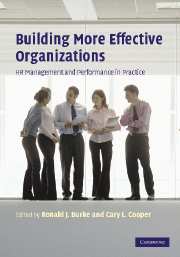Book contents
- Frontmatter
- Contents
- List of figures
- List of tables
- List of contributors
- Foreword
- Preface
- Acknowledgements
- Part I Building more effective organizations
- Part II Enhancing individual health and performance
- Part III Enhancing organizational health and performance
- 6 Maximizing the value of leadership development: key questions (and some answers)
- 7 Best practices in building more effective teams
- 8 Career development processes in organizations
- 9 Fostering organizational learning: Creating and maintaining a learning culture
- 10 Work–life balance, best practices and healthy organisations: A European perspective
- 11 Diversity management practices in leading edge firms
- Part IV Transforming organizations
- Index
6 - Maximizing the value of leadership development: key questions (and some answers)
Published online by Cambridge University Press: 05 June 2012
- Frontmatter
- Contents
- List of figures
- List of tables
- List of contributors
- Foreword
- Preface
- Acknowledgements
- Part I Building more effective organizations
- Part II Enhancing individual health and performance
- Part III Enhancing organizational health and performance
- 6 Maximizing the value of leadership development: key questions (and some answers)
- 7 Best practices in building more effective teams
- 8 Career development processes in organizations
- 9 Fostering organizational learning: Creating and maintaining a learning culture
- 10 Work–life balance, best practices and healthy organisations: A European perspective
- 11 Diversity management practices in leading edge firms
- Part IV Transforming organizations
- Index
Summary
The purpose of this chapter is to identify, summarize current thinking and best practices about, and provide some answers to the most important questions organizations must resolve as they attempt to systematically develop their current and future leaders. Some of these are obvious, while others are seldom considered in advance, so are usually answered by default. These questions need to be addressed by any organization that is serious about formulating a competent leadership development initiative:
What is the organization's working definition of “leadership,” and what kind of leadership is it seeking to develop?
What are the objectives of the leadership development initiative?
What should the content of the initiative look like?
Who is to be developed?
Who should be the faculty?
How should the success of the initiative be evaluated?
How should the leadership development group be organized?
What is the organization's working definition of leadership, and what kind of leadership is it seeking to develop?
During the last twenty years, as it has gained momentum and resonance in the business world, the term “leadership development” has been generalized to such an extent that it's not always clear what it means. One reason for the ambiguity surrounding the term is that, instead of being a one-size-fits-all, canned solution, the leadership development initiative of any organization needs to be specifically aligned with its mission, objectives, strategy and business model.
- Type
- Chapter
- Information
- Building More Effective OrganizationsHR Management and Performance in Practice, pp. 127 - 159Publisher: Cambridge University PressPrint publication year: 2007



